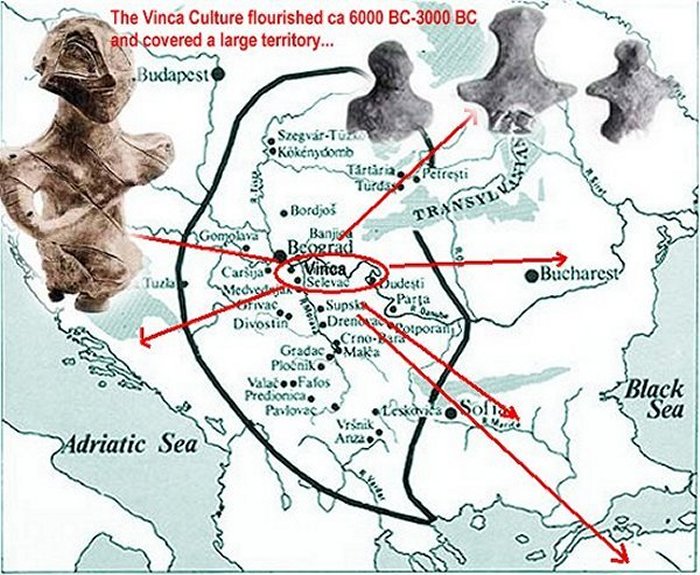Mysterious Vinca Culture Is Among The Most Advanced Prehistoric Societies In Europe
A. Sutherland - AncientPages.com - There was once a mysterious European culture, which left a legacy in the form of valuable artifacts covered with an unknown, never successfully deciphered script. These artifacts have been excavated from sites in south-east Europe.
The culture that flourished from about 6000 BC to 3000 BC, was named Vinca-Tordos Culture of Yugoslavia and western Romania and derived its name from the village of Vinca located on the banks of the Danube river, only 14 km downstream from Belgrade.
A century ago, a great discovery was made at the Danube riverbank. Panta, an old man from Vinča accidentally found a strange clay figurine: This mysterious figurine was puzzling to him so he took it to the National Museum in Belgrade in order to find the explanation. The figurine was soon recognized as an artifact that dated back to the late Stone Age.
Since then, a number of archaeological excavations have revealed numerous cultural layers of a civilization and its largest Neolithic settlement in Europe, dating back more than 7,000 years BC.
The Vinca legacy includes among others, curious masks and the most informative costumed figurines depicting women in extremely modern clothes like narrow skirts, and sleeveless upper-body panels, complimented with hip belts, aprons, jewelry, shoes, caps, hairstyles, bracelets, necklaces, and medallions.
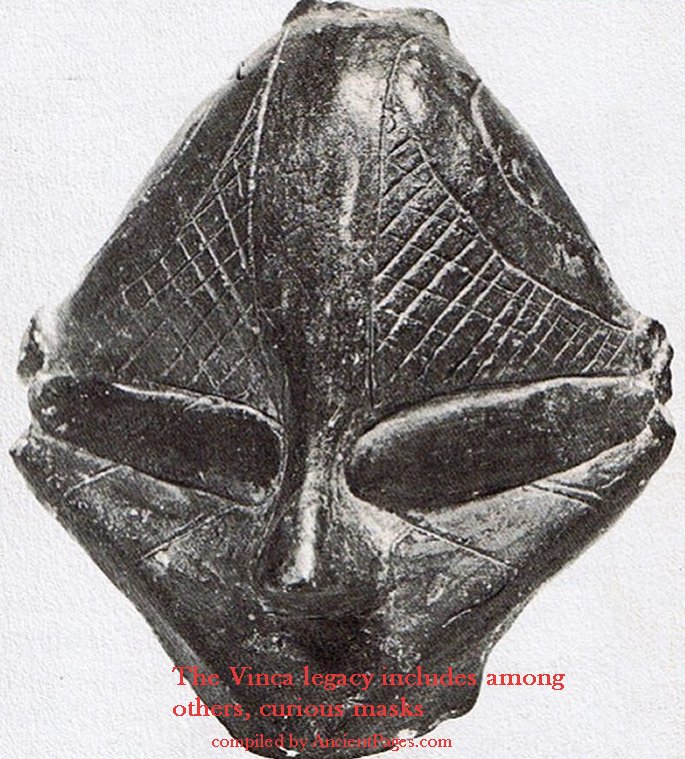 Prediconica mask, Vinca culture 4500 BC-4000 BC
Prediconica mask, Vinca culture 4500 BC-4000 BC
There have also been unearthed different kinds of tools and weapons and the remains of prehistoric houses with the furniture and many other objects created in the Vinca region or brought from remote areas.
Since the language of the Vinca still remains undeciphered, unearthed artifacts constitute the only source of knowledge about this culture. Vinca's living style reminds us of our own. They lived in houses that had very complex architectural layouts and several rooms.
The houses faced northeast-southwest and were separated by streets. Vinca people had stoves in their houses, preceding the Romans in using these devices. They used special holes only for rubbish, and had the same tradition as we have, to bury people in cemeteries.
The development of copper metallurgy is evident during the latter part of the Vinca culture's evolution.
Among unearthed artifacts, there have been found a large number of figurines made of clay and other artifacts depicting worshipped deities and women in miniskirts, short tops, wearing jewelry.
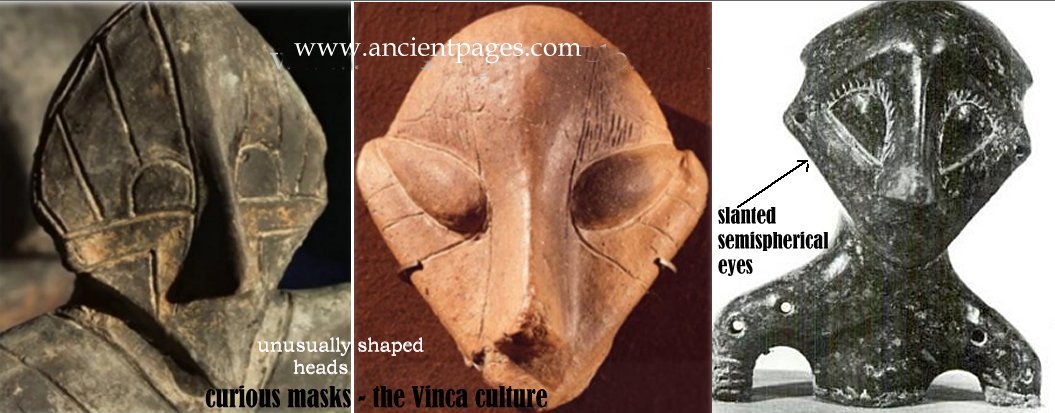
It is hard to believe that women that lived several millennia ago wore miniskirts, unless, the cult of Mother Goddess was very widespread and reached both the south-east parts of Europe and ancient India.
Similar, made of ceramic clay, figurines of Mother Goddess, were found in excavations in Mohenjo-Daro, located along the Indus River in ancient India (present-day Pakistan).
Was this kind of clothes popular 7,500 years ago?
The Vinca Culture - Europe's biggest prehistoric civilization - point to a metropolis with a great degree of sophistication and a taste for art and fashion.
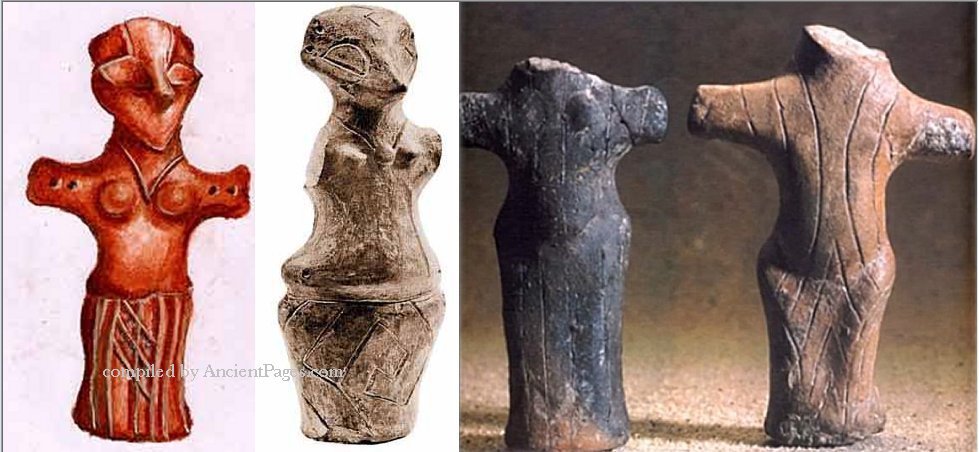
Numerous figurines related to the Vinca Culture bear 'markings that clearly indicate clothing, bequeathing a wealth of costume detail. The Vinca culture in the Danube River basin, from the end of the sixth through the fifth millennia B.C., left the most informative costumed figurines.
These images bear deep incisions encrusted with white paste or red ocher emulating fringe, hip belts, aprons, narrow skirts, and sleeveless upper-body panels. The Vinca artisans sans also modeled a variety of shoes, caps, hairstyles, bracelets, necklaces, and medallions...
Figurines with clothing and ornaments appear either bare-breasted or fully clad. Several dress combinations recur persistently on bare-breasted images. Some wear only a hip belt or a hip belt supporting either an apron or an entire fringed skirt. Others wear a tight skirt and nothing else...' 1
An important question is: Is the legacy of the Vinca culture evidence of the ever known earliest manifestation of the Divine Power and well-evolved and widespread Mother Goddess worship cult?
Many terracotta figurines of the Mother Goddess were recovered in excavations at various archaeological sites of Indus Valley. Naturally, orthodox science proposes a classical explanation to this phenomenon and say that the proto Mother, the symbol of female fertility, is depicted on prehistoric figurines.

On many of the artifacts excavated from sites in south-east Europe, there have been found the Vinca symbols. Here are common symbols used throughout the Vinca period:
They probably represent the earliest form of writing ever found and predating ancient Egyptian and Sumerian writing by thousands of years.
Since the inscriptions are all short and appear on objects found in burial sites, and the language represented is not known, it is highly unlikely they will ever be deciphered.
In some way, Vinca's past is both forgotten and lost.
The first version of this article was originally published on October 25, 2014
Written by – A. Sutherland AncientPages.com Staff Writer
Copyright © AncientPages.com All rights reserved. This material may not be published, broadcast, rewritten or redistributed in whole or part without the express written permission of AncientPages.com
Expand for referencesReferences:
- M. Gimbutas, Living Goddesses
More From Ancient Pages
-
 Ancient Cities Built By Biblical Giants – Archaeological Evidence
Ancient Mysteries | Jun 2, 2018
Ancient Cities Built By Biblical Giants – Archaeological Evidence
Ancient Mysteries | Jun 2, 2018 -
 On This Day In History: Ueshiba Morihei, The ‘Founder of Aikido’ Was Born – On Dec 14, 1883
News | Dec 14, 2016
On This Day In History: Ueshiba Morihei, The ‘Founder of Aikido’ Was Born – On Dec 14, 1883
News | Dec 14, 2016 -
 Famous Runestone Is Not What We Thought And Re-Writes History Of The Vikings – Scholar Argues
Vikings | Jan 23, 2025
Famous Runestone Is Not What We Thought And Re-Writes History Of The Vikings – Scholar Argues
Vikings | Jan 23, 2025 -
 Surprise! ‘Viking Ship’ Found On The Seabed Is Not What We Previously Thought And Rewrites Scandinavian Maritime History, Scientists Say
Archaeology | Mar 10, 2025
Surprise! ‘Viking Ship’ Found On The Seabed Is Not What We Previously Thought And Rewrites Scandinavian Maritime History, Scientists Say
Archaeology | Mar 10, 2025 -
 2000-Year-Old Room With Frescoes Discovered In Central Rome, Italy
Archaeology | Dec 4, 2015
2000-Year-Old Room With Frescoes Discovered In Central Rome, Italy
Archaeology | Dec 4, 2015 -
 Gigantic Asipatra: Terrifying Mythical Monster Bird In Hindu Beliefs
Featured Stories | Jun 14, 2017
Gigantic Asipatra: Terrifying Mythical Monster Bird In Hindu Beliefs
Featured Stories | Jun 14, 2017 -
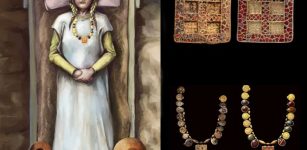 Mystery Of The Anglo-Saxon Harpole Burial Continues – New Clues
Archaeology | Dec 14, 2023
Mystery Of The Anglo-Saxon Harpole Burial Continues – New Clues
Archaeology | Dec 14, 2023 -
 Fire Reveals Notre-Dame De Paris Cathedral Was Historical First In Using Iron Reinforcements In The 12th Century
Archaeology | Mar 17, 2023
Fire Reveals Notre-Dame De Paris Cathedral Was Historical First In Using Iron Reinforcements In The 12th Century
Archaeology | Mar 17, 2023 -
 Did The Inca Use The Quipu To Collect Taxes?
Archaeology | Jun 24, 2019
Did The Inca Use The Quipu To Collect Taxes?
Archaeology | Jun 24, 2019 -
 Does A Baffling Artifact Offer Evidence Of Ancient Extraterrestrial Visitation In New Zealand? – The Discovery – Part 1
Ancient Mysteries | Jul 20, 2020
Does A Baffling Artifact Offer Evidence Of Ancient Extraterrestrial Visitation In New Zealand? – The Discovery – Part 1
Ancient Mysteries | Jul 20, 2020 -
 Weird Archaeological Discovery In Ancient Scottish Cave – A Neolithic And Celtic Mystery
Featured Stories | May 30, 2024
Weird Archaeological Discovery In Ancient Scottish Cave – A Neolithic And Celtic Mystery
Featured Stories | May 30, 2024 -
 On This Day In History: Unua Libro ‘First Book’ Describing Esperanto Published – On July 26, 1887
News | Jul 26, 2016
On This Day In History: Unua Libro ‘First Book’ Describing Esperanto Published – On July 26, 1887
News | Jul 26, 2016 -
 Hundreds Of Marvelous Ancient Egyptian Treasures Found Inside Tombs In Minya
Archaeology | Oct 27, 2020
Hundreds Of Marvelous Ancient Egyptian Treasures Found Inside Tombs In Minya
Archaeology | Oct 27, 2020 -
 Historian Discovers Artifacts And Skeletons Of An Ancient Unknown Race In The North American Desert
Ancient Mysteries | May 6, 2024
Historian Discovers Artifacts And Skeletons Of An Ancient Unknown Race In The North American Desert
Ancient Mysteries | May 6, 2024 -
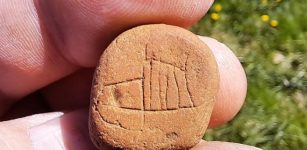 Small Stone Carved With A Viking Ship May Be Oldest Picture Ever Found In Iceland
Archaeology | Jun 16, 2023
Small Stone Carved With A Viking Ship May Be Oldest Picture Ever Found In Iceland
Archaeology | Jun 16, 2023 -
 Dinosaurs Were On The Up Before Asteroid Downfall – Study Finds
Archaeology | Dec 8, 2022
Dinosaurs Were On The Up Before Asteroid Downfall – Study Finds
Archaeology | Dec 8, 2022 -
 On This Day In History: Universal Declaration Of Human Rights Adopted – On Dec 10, 1948
News | Dec 9, 2016
On This Day In History: Universal Declaration Of Human Rights Adopted – On Dec 10, 1948
News | Dec 9, 2016 -
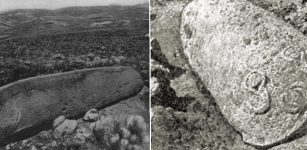 Mysterious 2000-Year-Old Carved Vishap Stone Monuments Of Armenia
Featured Stories | Dec 13, 2016
Mysterious 2000-Year-Old Carved Vishap Stone Monuments Of Armenia
Featured Stories | Dec 13, 2016 -
 Mysterious Hammer Of Thor In Canada Was Built Before The Arrival Of The Inuit – Did Vikings Raise The Monument?
Featured Stories | Jan 22, 2018
Mysterious Hammer Of Thor In Canada Was Built Before The Arrival Of The Inuit – Did Vikings Raise The Monument?
Featured Stories | Jan 22, 2018 -
 Rare Medieval Hall Found Near Norman Castle At Skipsea, UK
Archaeology | May 15, 2024
Rare Medieval Hall Found Near Norman Castle At Skipsea, UK
Archaeology | May 15, 2024

